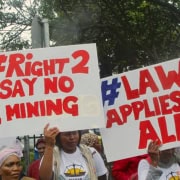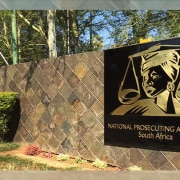|
Getting your Trinity Audio player ready...
|
Our new two-part mini-series digs into a corruption topic not discussed as often as many others, but which is becoming more and more urgent – gold laundering. Part one sets the scene and looks at possible measures to address the growing problem, and part two looks back into South Africa’s gold mining history and the role gold laundering played in financing the apartheid government’s attempts to cling to power.
We’ve heard of blood diamonds, or conflict diamonds – those precious stones historically mined in war zones, for the most part in Africa, and sold by rebel forces to fund their efforts against the legitimate governments of countries such as Angola, Sierra Leone, and Liberia. Though many of the wars have ended, conflict diamonds are still an ongoing problem.
A blood mineral is used to fund conflict and human rights abuses, usually because it is valuable and can be exchanged for useful sums of money. So it is with blood gold, which is known to have fuelled conflict in the Democratic Republic of the Congo and Sudan, for example. Gold has also been used to fund violent organised crime, in particular in Latin America.
Usually found as in the native metal state, gold is highly malleable and ductile, and resistant to corrosion and other chemical reactions. For this reason it is sought after for numerous uses, including jewellery, electronics, medicine, cuisine, art, and more. It is also prominent in central bank reserves and investment.
Gold is mined around the world, through numerous techniques, and is used primarily in jewellery and consumer electronics. The product that is specifically described as blood gold is extracted in various regions around the world, most notably in Latin America and West Africa. In these areas – particularly in the former, reported Reuters as far back as 2016 – criminal organisations control the industry and use human trafficking to populate their workforces.
Furthermore, while gold may not always be of the blood variety, there is no doubt that its extraction, supply and refinement has brought “incredible misery to many people”, says Prof Mark Pieth, president of the board of the Basel Institute on Governance (BIG), in his book Gold Laundering: The dirty secrets of the gold trade. People like “the hundreds of thousands of black labourers toiling in South African mines under apartheid, in wretched conditions and with their meagre salaries falling in real terms. Slaves, from the convicts and prisoners of war used by Egyptian pharaohs to those working under conditions of forced labour in the eastern Democratic Republic of Congo.”
Since most gold-mining sites are in the Global South, in many cases in unstable countries, Pieth notes, corruption and extortion are a high risk, as early as the mining rights process.
Corruption Watch’s work since 2016 with mining-affected communities in South African provinces has revealed major corruption in the mining rights application stage. Our research has uncovered numerous vulnerabilities in the mining application process, which give rise to corruption between mining companies, government authorities and community leaders, often to the detriment of mining-affected communities. Some of the flaws we found involve limited scope for consultations with communities, with no systems in place to ensure that meaningful consultation is taking place, the fact that communities are disadvantaged because documentation is often in English only, and the inordinate amount of discretionary power of some DMR officials when it comes to granting licences, because there are no clear guidelines on how power is to be exercised.
Demand for and supply of gold fuels greed and criminality, and not just because it is a valuable commodity. Illegally mined gold has to be inserted into the market without setting off alarms. This is where gold laundering enters the picture.
Where does the gold come from?
Gold mining conjures up images of the frenetic gold rushes of the 19th century, in the US, New Zealand, Australia, South Africa, and Canada. South Africa’s gold rush led to the establishment of Johannesburg, as well as companies such as Anglo American, Gold Fields, and AngloGold Ashanti. The country quickly became the world’s largest gold producer and held that top position from 1905 to 2007, when China overtook it. To date it has produced around 30% of all the gold ever mined.
China is still the world’s top gold producer, followed by Australia and Russia. South Africa has slumped to 12th position on the list. On the African continent, Ghana overtook South Africa as the top gold producer in 2018.
Today there are a number of methods used to extract gold. They include:
- Large-scale mining, undertaken by well-heeled multinational firms who have the capital to start up and maintain gold mines, whether on the surface, underground, or in the deep sea.
- Artisanal and small-scale mining (ASM) – these activities, in many developing countries, are largely undertaken for reasons of poverty alleviation, yet they play an important economic role. Artisanal usually refers to informal, unorganised mining, while small-scale is more organised and typically has a higher revenue turnover.
- Dredging involves digging up and sifting river silt, then allowing gravity to separate out the heavier elements. This may be an artisanal or commercial activity.
- Intermediaries in doré – this term refers to a semi-pure alloy of gold and silver, which is produced on-site at a mine and is sent to refineries for further processing. The trading of doré is an often opaque area, says Pieth, because trade rarely takes place directly between the mine and the customer. “Traditionally – even in a formalised supply chain – small local traders buy from artisanal miners and sell on to big national exporters, so-called collectors. These in turn sell to regional and global buyers, and refineries.”
- Recycling, of either high-value gold or industrial gold, accounts for about between a quarter and a third of the world’s gold production. When the price of gold skyrocketed after the financial crisis of 2008, says Pieth, cash-for-gold merchants sprang up everywhere. However, the Financial Action Task Force (FATF) warns that these are appealing to organised crime groups who are looking for new ways to launder money.
- Grandfathered gold is a special class of gold defined by the OECD in its system to control conflict minerals. The term refers to stocks of refined gold held in central banks or bank vaults, with a verifiable production date of before January 2012.
A dangerous game
Profits from illegal gold mining can be higher than those from drug trafficking, says Pieth in a briefing note for the BIG.
Informal gold mining is not necessarily the same as illegal mining. The former is largely done by unlicensed operations or those which not been formalised, especially in traditional communities. Illegal mining, on the other hand, is an activity by criminal organisations and a product of environmental and human rights crimes. The bosses force miners to work for them, or they extort illegal taxes from miners. Child labour and human trafficking, particularly of women who are them forced to offer sexual services to mining groups, are also linked to illegal mining.
Pieth’s book focuses on illegal mining and laundering in Latin America, but this is not the only region where it takes place. South Africans, for instance, will be familiar with zama zamas, who pose a threat not only to themselves by working in abandoned and unmaintained mines, but to communities around their areas of operation – mainly on Gauteng’s east and west rands. The prospect of turf wars between rival mining groups has already proved fatal, and shootouts between illegal miners and security forces are not unheard of. In August 2022 the nation reeled after shocking reports of the rape and robbery of eight women in Krugersdorp, allegedly by zama zamas. The charges have since been dropped because of lack of evidence.
“Many of the gangs involved are the same ones that run lucrative cocaine rackets and who now find gold a tempting money-spinner,” Pieth says. “The two commodities have common features: they can both be sourced in remote areas, far from government eyes, and even a small quantity is worth a fortune. Gold is used in everything from bullion in central bank vaults to jewellery, computers and mobile phones. Even if we don’t wear a ring, we all make daily use of gold.”
Laundering the spoils
Like illicit flows of money, illegal gold cannot be disposed of through normal channels. Instead, a complex supply chain involving corruption, smuggling and laundering comes into play, disconnecting gold sold in the retail or commercial market from its criminal origins or unethical handling, where such exists. If your favourite necklace originated in a crisis zone in Sudan, you would never know it.
“Gold is traded, collated, processed, shipped or smuggled across borders – all multiple times by different actors – and then refined.”
Mining and raw materials tracking organisation Minespider provides insight into the stages of the gold laundering process:
- Gold is acquired from any combination of sources, at least one of which is illegal. Certain small-scale gold mines, artisanal mines, and mines having no permits or licences, may extract gold from areas where government oversight is ineffective, or government officials are covertly participating in illegal extraction.
- The gold is melted and cast into a mould.
- The resulting ingot or bullion is easily transported to be sold by traders or brokers to smelters. Illegal ingots can be inserted into loads of recycled gold or newly mined legal gold, “effectively integrating the illegal gold into the supply chain”.
Gold does not even have to be physically present in the laundering scheme. “Individuals may register gold exports with their customs agency by providing false documentation of sale, and then import cash in exchange for the fictitious gold.” As an example, Minespider goes on to say: “The small Caribbean island of Curacao reported gold exports worth $435-million in 2017 – despite not having an operational gold mine.”
Once sold, the gold goes off to be refined. Whether knowingly or not, says Pieth, refineries play a key role in the human suffering and criminality caused by illegal mining, says Pieth, and they must accept responsibility accordingly. These industrial giants have often failed in their duties, he adds, just as banks have offered their services to launder the proceeds of crime. This is not because refineries are involved in illegal activities, but because they are located at a critical point in the gold supply chain and therefore can potentially play a significant role in efforts to clean up gold supply chains.
Once gold reaches the refiner and is processed, it is virtually impossible to track its past. “Refineries are the ones who decide whether to accept this gold or not. They are the gatekeepers to the nice world of clean gold, of jewellery, big finance, and reserve banks.”
What is the best way forward?
Business has an obligation to respect human rights, says Pieth, but apart from laws on responsible business conduct and conflict minerals, the gold industry is mostly self-regulated. “Companies may choose to commit to voluntary standards developed by industry associations including the LBMA, Responsible Jewellery Council and World Gold Council. This voluntary system relies on third-party audits and is not enforced by law.”
Pieth suggests, as a first step, that stakeholders agree on the urgent need to strengthen the third-party audits that are supposed to enforce the system of self-regulation.
There is already forward motion in some areas. Prominent jewellers and watchmakers are starting to pledge that they will only source gold from certified ethical, or green sources. Also, “Investors are also increasingly attentive to the environmental, social and governance risks of the gold trade.”
In addition, the relentless efforts of investigative journalists and NGOs such as Human Rights Watch and Public Eye are bearing fruit in terms of raising awareness of these grave issues. “Younger generations are embracing ethical consumerism and demanding products that haven’t harmed the planet or its people.”
In Switzerland, where most of the world’s gold is refined, the country’s Federal Audit Office in 2020 criticised the inadequate control of imports of gold into the country, saying the current system is not equipped to prevent illegal gold from entering. Because customs data is not sufficiently transparent to differentiate between mined gold, bank gold and recycled gold, all of which are imported under the same code, criminals have free rein to sneak bars of “dubious origin” into the country.
Authorities have called for stricter rules and stronger oversight. “Put simply, there are no guarantees as to the traceability and legality of gold entering Switzerland, particularly as it often transits through a third country, thus obscuring its true origin.”
Pieth cautions against targeting certain sections of the supply chain in a well-intentioned but misguided attempt to source clean gold. “An example is the action of one Swiss refinery that, with the aim of ensuring a more traceable and transparent gold supply chain, imposed a blanket ban on all gold from small-scale miners. Boycotting small-scale mining will harm and not help the estimated 100-million people worldwide who rely on it for their livelihoods.”
It will also not help the industry or consumers concerned about human rights. Small-scale mining contributes around 20% of the world’s newly mined gold, Pieth says, and large-scale gold mining is not risk-free. “Cutting off ASM supply chains can have severe collateral damage while increasing the environmental and human impacts of industrial or large-scale mining.”
Rather, he sees the way forward as one of collaboration. The BIG has set up a programme titled Collective Action, which seeks to co-operatively address corruption challenges and raise standards of integrity and fair competition in business.
Among others, Collective Action initiatives help to:
- raise standards of integrity across industries locally and worldwide;
- develop best practice self-regulatory standards within specific industry sectors;
- solve systemic issues related to bribery and corruption;
- enhance conditions for fair competition and level the playing field between competitors.
Pieth sees possibilities for further collaboration and support in, for instance, technologies to eliminate the use of mercury or blockchain technologies to increase the transparency of supply chains. Developing common due diligence standards and processes to lighten the burden on legitimate gold traders, and help flag bogus ones, could be another.
“Many such useful efforts are already underway by different actors in different parts of the world. Coming together will give them the critical mass they need to succeed.”
Don’t miss part two of our gold-laundering mini-series, coming soon, in which we go back into South Africa’s gold mining history and the role gold laundering played in financing the apartheid government’s attempts to cling to power.








